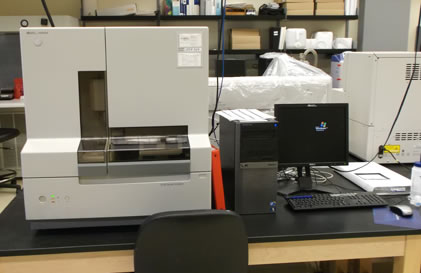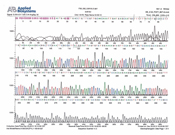DNA Applications
DNA Sequencing
- Multi-Capillary DNA sequencing- ABI 3130
- $7.50/reaction.
- Finished sequences will be emailed and/or printed in approximately 48 hours.
- Request form.
- More Information.
Oligonucleotide Synthesis
- We now order through IDT (Integrated DNA Technologies, Inc.)
- $0.25/base.
- $11.25 shipping on orders under $50.
- Free shipping on orders over $50.
- Usually delivers in 48 hours.
- Request form
MORE INSTRUMENT INFORMATION
ABI 3130 INFORMATION
OVERVIEW

Applied Biosystems 3130 Genetic Analyzer is used for DNA sequencing. This is a 4-capillary
electrophoresis system, giving maximal run flexibility. The facility will provide
some common primers and perform the cycle sequencing and analysis. The user must supply
the template DNA, in water, at a specified concentration and any custom primers that
are to be used. The facility can also perform small "project " sequencing by designing
and ordering primers, sequencing the data and editing and assembling the contiguous
fragments.
SEQUENCING CHEMISTRY
The ABI 3130 "detects fluorescence from four different dyes that are used to identify the A, G, C, and T extension reactions. With dye terminator labeling, each of the four dideoxy terminators (ddNTPs) is tagged with a different fluorescent dye. Thus, the growing chain is simultaneously terminated and labeled with the dye that corresponds to that base." (1) Some advantages of using dye-labeled terminators are that an unlabelled primer can be used (which can be designed, synthesized and quantified by the facility), and four sequencing reactions are performed in a single tube and run in a single capillary run.
REACTION SET-UP
The Core Facility uses cycle-sequencing protocols and chemistry kits optimized and provided by Applied Biosystems to ensure accurate and reproducible results from a range of templates (e.g. single-stranded and double-stranded DNA, PCR product direct sequencing, phage DNA). A sequencing run typically provides approximately 700 bases and data is usually available within 48 hours. The facility carefully monitors all reagents and the highly automated capillary system is frequently tested. These steps, in combination with the use of pre-mixed kits, allows for minimal pipetting and sample handling steps to minimize variability in results. The Facility also provides common sequencing primers which have been synthesized, quantified, and tested in-house, at no extra charge. This leaves the quality of the template DNA as the major variable impacting the quality of sequence data. "In fact, inadequate template preparation is the most common cause of sequencing problems. Both the method of purification and host strain variability can impact the quality of template preparation. Potential problems include protein contamination, quantitation problems due to contaminants such as RNA or chromosomal DNA, and residual salts and other contaminants (from reagents used in the preparation, from the media, or from the cells)."(1) Currently we do not perform template preparation in the Facility but can provide information about preparation methods which appear to be successful/unsuccessful in a variety of research labs. For optimal results, we recommend that template be provided in water at a concentration of 100ng/ul. We typically use 300-500 ng of template per sequencing reaction for plasmid DNA. For direct sequencing of PCR products, we require approximately 10 ng of template per 100 bases of length for each reaction (100 ng for a 1 kb PCR product). The amount of DNA template required for sequencing phage (or any very long DNA template) is greater (reaction requires 1000-1500 ng) and thus must be more concentrated (500 ng/ul) in order to fit within volume constraints associated with using a kit. Primers, if not provided by the facility, should be dissolved in water at a concentration of 1pmol/ul (1uM). Each reaction requires ~2ul of primer at this concentration. We require double this amount for phage sequencing.
SEQUENCING ANALYSIS
Results can be mailed and/or e-mailed as a color printout chromatogram with text above peaks.

We highly recommend careful scrutiny of the chromatogram and editing of text before using the text for other purposes, as the computer can make errors in its base-calling function. There is free software on the web entitled Chromas which will enable viewing of the chromatogram on your computer (http://www.technelysium.com.au/chromas.html). We can also assist you in designing, synthesizing, and quantifying primers, as well as editing and assembling contigs.
Please call if you have any questions or if we can assist you in your DNA synthesis or sequencing needs.
(1) ABI Prism DNA Sequencing Chemistry Guide, Version A, May 1995, Perkin-Elmer Corporation
Center for Biotechnology & Genomics
-
Address
Texas Tech University, Canton & Main Experimental Sciences Building, Room 101, Lubbock, TX 79409, Mail Stop 3132 -
Phone
806.742.6927 | Fax: 806.742.3788 -
Email
chiquito.crasto@ttu.edu
